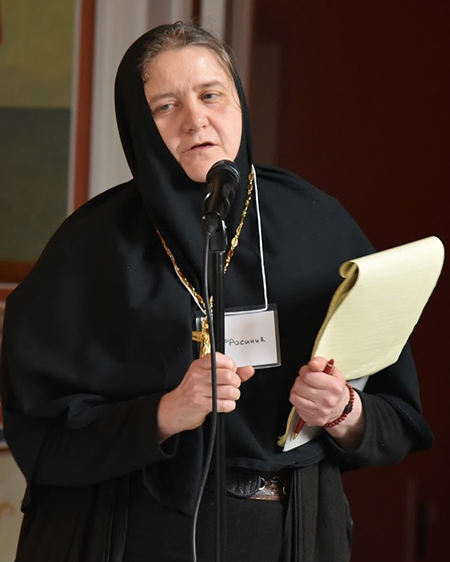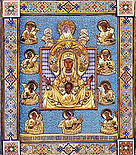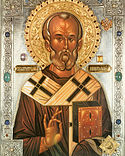7th Report of the VI All-Diaspora Council – by Vitaliy Shumilo (read by mother Efrosinia)- on the “Sekach” Bishops

(reading this report was mother Efrosinia)
Apostolic succession is one of the main principles of canon law in the Orthodox Church and is the means through which the church hierarchy traces its direct succession, through an unbroken series of consecrations (cheirotonia) of bishops, to the apostles chosen by the Lord Jesus Christ. The Church teaches that the grace of the Holy Spirit that the apostles received on the Pentecost is passed on through the act of consecration. The first episcopal consecrations of the successors to the apostles were performed, according to the Gospel, directly by the apostles (Acts 14:23, 2 Timothy 1:6, and others), who instructed their disciples to perform subsequent consecrations following their example (Titus 1:5, 1 Timothy 5:22).
The idea of apostolic succession was first formulated in the 1st century by St. Clement of Rome, one of the seventy apostles, in his 1st Epistle to the Corinthians: “Our Apostles, too, by the instruction of our Lord Jesus Christ, knew that strife would arise concerning the dignity of a bishop and on this account, having received perfect foreknowledge, they appointed the above-mentioned as bishops and deacons: and then gave a rule of succession, in order that, when they had fallen asleep, other men, who had been approved, might succeed to their ministry…” That is, the doctrine of apostolic succession is the essential condition for the existence of the Church of Christ and its legal hierarchy traces directly from the apostles. St. Clement particularly emphasized that apostolic succession is necessary precisely because “strife would arise concerning the dignity of a bishop” in the Church and that the criterion for analyzing such “strife” must be proof (or conversely, the refutation) of the continuous chain of apostolic succession.
In exposing sectarians-heretics who imitate a church, the 3rd century Church teacher Tertullian wrote: “Let them produce the original records of their churches; let them unfold the roll of their bishops, running down in due succession from the beginning in such a manner that the first bishop of theirs shall be able to show for his ordainer and predecessor some one of the apostles or of apostolic men, (a man, moreover, who continued steadfast with the apostles). For this is the manner in which the apostolic churches transmit their registers.” In other words, the main criterion since ancient times that distinguishes a sect from the Church, is the lack in the sect of the grace of apostolic succession, a legitimate episcopal consecration leading back to the beginning through the apostles at Pentecost. No other source exists in the Church for the transmission of the Holy Spirit’s grace except by episcopal consecration tracing back to the apostles.
The presence or absence of apostolic succession is thus the fundamental (but not only) characteristic (aside from a correct Orthodox faith) and the reliable yardstick by which a Christian can distinguish the Church from sects.
In the case of the so-called “Sekach hierarchy,” which was begun by Mikhail (Serafim) Pozdeyev, it is specifically doubts about the presence of apostolic succession in this group that prompted the Synod of Bishops of the Russian Orthodox Church Abroad to issue its well-known resolution of August 2/15, 1990 (No.4/77/135): “The Synod of Bishops of the Russian Orthodox Church Abroad, whose authorized representative in Russia is His Grace Lazar, Bishop of Tambov and Morshansk, with regret must conclude that it finds it impossible, in light of the lack of (or the failure to provide) proper evidence, to recognize the apostolic succession and canonicity of the consecrations of these clandestine hierarchies.”
The “sekachevtsy,” who did not recognize this decision, widely promoted the view, which even penetrated the ranks of the ROCA, that Bishop Lazar (Zhurbenko) deliberately slandered the “Sekach” hierarchy, motivated by a hunger for power and wanting to remain the sole representative of the Church Abroad in the vast space of the USSR. This charge is too serious and must be either confirmed or refuted.
What guided the ROCA Synod in reaching its decision and what information did they possess in 1990 about the origins of the “Sekach hierarchy?”
According to the official version of the “sekachevtsy” themselves, Archbishop Serafim of Smolensk (Mikhail Pozdeyev), three days before his death (12 April 1972) consecrated as a bishop Hieromonk Gennadiy (Sekach), from whom the “Sekach hierarchy” is derived. This “consecration” was not performed during a liturgy but rather in Pozdeyev’s monastic cell. Pozdeyev, ill and almost immobile, took off his bishop’s panagia and put it on Fr. Gennadiy with the words “You will be a bishop,” and then put it back on himself. This was attested to by eyewitnesses to the “consecration” of Gennadiy Sekach – matushka Vera Shabelnik-Kalyuzhnaya, the wife of the late catacomb priest Aleksandr Shabelnik who knew Serafim Pozdeyev in the last years of his life, and by Serafim Pozdeyev’s novice Lyudmila Saadayeva.
The author of this report, who in the early 1990s conducted his own “investigation” into the presence or absence of lawful episcopal consecrations in the “Sekach hierarchy,” can confirm that the “sekachevtsy” themselves, and in particular one of their more influential bishops, Metropolitan Epifaniy (Kaminskiy) from Svetlogorsk (Belarus), did not deny the fact that the “consecration” of Gennadiy Sekach was conducted in such a dubious manner, ascribing it both to the persecution of religion that made it “impossible” to perform the consecration during a liturgy, and to the extraordinary circumstance of the ill Seraphim Pozdeyev being no longer able to serve the liturgy.
Subsequently in 1997, the fact of the “consecration” of Gennadiy Sekach from a bed in a monastic cell was confirmed in documents (see photocopy of the written testimony of Vera Shabelnik-Kalyuzhnaya dated February 27, 1997).
Thus, even if Mikhail Pozdeyev was really Bishop Serafim of Smolensk, who received his consecration “from Patriarch Tikhon, a few days before the death of the patriarch” (again “a few days before death”!), the manner in which the “consecration” of Gennadiy Sekach was conducted is more than suspect and cannot be recognized by the Russian Orthodox Church Abroad. The best accommodation that the ROCA Synod could offer, and what it did offer based on the principle of pastoral stewardship (oikonomia) and out of love for the “Sekach” clergy and congregations who dwelled in the catacombs, was the assistance of the ROCA in insuring that their episcopal and priestly ordinations met canonical norms: “The Synod of Bishops of the Russian Orthodox Church Abroad has determined that the clergy (priests and deacons) who were vested in the above group and who wish to enter into Eucharistic communion with the Russian Orthodox Church Abroad and the free Russian Orthodox Church, must settle their canonical status through vestiture (if they face no canonical obstacles) from the hand of a bishop recognized by the Russian Orthodox Church Abroad.
At the same time, the Synod of Bishops, for the sake of church unity for the flock that carries its confessional cross in the Russian catacombs, encourages all catacomb bishops, for the good of the Holy Church, to document the authenticity of their apostolic succession, to provide compelling evidence of their consecrations, or to take steps to remedy their cheirotonia.” The “Sekach hierarchy” did not accept the helping hand of the ROCA and instead accused ROCA Bishop Lazar (Zhurbenko) of slandering Mikhail Pozdeyev and Gennadiy Sekach.
It is widely known that most of the old catacomb priests who were vested by Patriarch Tikhon, did not recognize the episcopal consecration of Serafim Pozdeyev. He was also not recognized by the last authoritative canonical hierarch of the Catacomb Church, Schema-Bishop Petr (Ladygin). Mikhail Pozdeyev first announced himself as a bishop in 1939, and prior to that date no one had ever heard of a “Bishop Serafim Pozdeyev of Smolensk.”
For lack of time, we will not now investigate the origin cover story of Bishop Mikhail-Serafim Pozdeyev that he himself related. Suffice it to say that even in the 1940s, not many believed this cover story and strong evidence was found to refute it.
For our purpose today, let us address the documentary evidence that Mikhail Pozdeyev was not only not a bishop, but was not even a priest. He referred to himself first as “Hieromonk Antoniy,” then as an “Archimandrite” and finally, as “Bishop Serafim,” but he was in fact a freelance NKVD collaborator.
In 2000, the Ural Branch of the Russian Academy of Sciences issued a two-volume monograph by V.A. Alekseyev and M.Yu. Nechayeva, historians from Yekaterinburg, that published declassified documents from the NKVD archives. The first volume of this edition (400 pages of fine print) was almost entirely devoted to the adventurer Mikhail Pozdeyev, who posed as the “brother of Tsar Nikolay II, the Grand Duke Mikhail Aleksandrovich,” who had miraculously escaped execution. This research by Alekseyev and Nechayeva was titled “Resurrected Romanovs?: A History of Impostors in 20th century Russia,” and focused solely on the many adventurers who in the 1920s and 1930s posed as members of the Tsarist family “who escaped execution.” In the case of one of these impostors, Mikhail Pozdeyev, who was arrested and then collaborated with the NKVD, the Yekaterinburg historians examined his case in the NKVD archives. When the researchers got to materials from the 1940s, it became clear to them that the “Grand Duke Mikhail Aleksandrovich Romanov” and “Bishop of Smolensk Serafim Pozdeyev,” the founder of the so-called “Sekach hierarchy,” were one and the same person, and that the NKVD knew in minute detail all of the adventures and provocations, including names, addresses, and so on, of Mikhail Pozdeyev from the words of Pozdeyev himself.
The declassified investigative materials reveal that Mikhail Pozdeyev was born in the village of Debesy in Udmurtia in 1887, and for some time earned money as a traveling artist, then for a few years (one document indicates for two years, another for five years from 1903 to 1908) he was a novice at the Nikolayev monastery in Belogorsk and at the Makarev monastery in Sviyazhsk, but he was not tonsured or ordained, and left the monastery to wander as a beggar. Begging became easier after the 1917 revolution and the beginning of the persecution of the Church, as one could appeal to the compassion of Orthodox believers for persecuted clergy. Pozdeyev first posed as a “monk,” a novice to a 112-year-old elder Makariy who secretly hid from the Bolsheviks in a cave, then he posed as “Hieromonk Antoniy,” performing religious rites in cemeteries and villages, and then, as the “Grand Duke Mikhail Romanov.” In 1927, posing as “the Grand Duke,” Pozdeyev was arrested and convicted for the first time to a long period of imprisonment, at which time he signed on as a collaborator with the NKVD. Preserved in his investigative file is a statement Pozdeyev wrote out in his own hand that “if I hear from someone, or see, or learn of someone who speaks against the authorities, I will immediately inform wherever instructed.” However, these case files reveal that Pozdeyev was first recruited in 1923 by the Perm regional branch of the OGPU. After serving his prison sentence, in the mid-1930s Pozdeyev declared himself the representative of the Patriarchal locum tenens Metropolitan Petr (Polyanskiy) who was in custody and who allegedly dispatched him to collect funds for repressed clergy. In September 1935 Pozdeyev was again arrested on suspicion of divulging his cooperation with the NKVD, but he was able to prove that he had not disclosed this information, and he was released. At this time, posing as a representative of Metropolitan Petr, Pozdeyev was not yet calling himself “Archbishop Serafim.” Mikhail Pozdeyev first declared himself “Archbishop Serafim” in 1939, after serving a prison term resulting from his arrest in 1936. He moved to Ukraine, where he engaged in a virtual storm of almost legitimate activity. Given that in 1939 all of the bishops and most of the clergy of the True Orthodox Church had been either executed, or in the case of those who survived, were in the deep underground, it was not too difficult to pretend to be a persecuted bishop, as there was no one left who could investigate the authenticity of his episcopacy. M.Yu. Nechayeva, analyzing the NKVD archive materials on Pozdeyev for the year 1940 came to the conclusion that “Mikhail Pozdeyev continued cooperation with the NKVD;” it is also possible that Mikhail Pozdeyev declared himself as “Archbishop Serafim” at the instruction of the NKVD. Perhaps not coincidentally, this was the story that established itself in the 1960-1970s, i.e. during the period when the Catacomb Church in the USSR was without bishops, and it became the basis for the creation of the so-called “Sekach branch of the Catacomb Church,” which gave rise to a sectarian structure far removed from Orthodoxy. There were also serious suspicions about the KGB collaboration of the former Moscow Patriarchate priest Gennadiy Sekach (who served in the village of Verbovka, Chernigov region), and who propagated in the Russian catacombs the “hierarchy” of NKVD collaborator Mikhail Pozdeyev, but Sekach’s biography, as well as that of those he consecrated as “bishops,” is beyond the scope of this report.
I venture to suggest that this structure was deliberately created by the NKVD-KGB with the aim of creating a sect controlled by the “authorities” in the guise of the persecuted Catacomb Church, and thus leaving real Catacomb Christians without priests. The fact that many of the “Sekach” bishops, while remaining illegal bishops of the True Orthodox Church, continued to legally serve as priests in the parishes of the MP, speaks for itself.
It is not currently possible to investigate this supposition because materials that are available to historians regarding Mikhail Pozdeyev end in 1955, that is with the reorganization of the NKVD into the KGB, and as we know, these materials remain classified.
At the time, the website “Church Gazette” published several articles by M.Yu. Nechayeva dedicated to Mikhail Pozdeyev. To avoid repetition, we would refer those interested to two of her two articles: “Serafim Pozdeyev – ‘Patriarch of Solovki’? Cover Story and Historic Versions of a Biography,” in particular to the article’s chapters “The Exemplar Arrested” and “The Witting Informer;” and “From ‘Grand Duke’ to ‘Archbishop’,” The Evolution of the Impostor Mikhail Pozdeyev in the Context of the Church Environment.” These materials more fully delve into the biography of the adventurer Mikhail Pozdeyev and his “evolution from Grand Duke to Archbishop.”
With the publication in 2000 by V.V. Alekseyev and M.Yu. Nechayeva of the huge body of archival material (some 400 pages of fine print), setting out the genuine and not the cover story biography of the founder of the “Sekach hierarchy,” Mikhail-Serafim Pozdeyev, as well as after the publication by M.Yu. Nechayeva of a series of research articles devoted to Pozdeyev (many of which are accessible on the Internet), the assertion that the “sekachevtsy” possess the grace of apostolic succession is, to say the least, unfounded.
M.Yu. Nechayeva, as a secular not ecclesiastical historian, was involved in studying the phenomenon of impostors in the USSR, and came upon Mikhail-Serafim Pozdeyev by chance in the context of this study. She did not suspect that by studying NKVD investigative files of the 1920-1930s about impostors posing as surviving “Romanovs,” she would be exposing one of the greatest adventurers, informers, and NKVD collaborators, Mikhail Pozdeyev, who laid the foundation of the so-called “Sekach hierarchy” that to this day purports to be the Catacomb Church. However, “for there is nothing hidden that will not be disclosed” (Luke 8:17), as soon as the true origin of the “Sekach hierarchy” is finally widely known, there cannot be the slightest doubt that this “hierarchy” does not have the grace of apostolic succession. It is essential that we recognize that the decision of the Synod of Bishops of August 2/15, 1990 not recognizing the “Sekach hierarchy” was correct and must continue to be enforced. The time has come to refute the accusation against Archbishop Lazar (Zhurbenko) that he slandered Mikhail Pozdeyev and Gennadiy Sekach.
1 “Testimony of how Serafim Pozdeyev conducted “chierotonia” on Gennadiy Sekach and Alfey Barnaulskiy.” Church Gazette: The Spiritual Legacy of the Catacomb Church and the Russian Orthodox Church Abroad, (http://catacomb.org.ua/modules.php?name=Pages&go=page&pid=1782).
2 For more information see: “On the origins of the uncanonical groups of ‘Sekachevtsy,’ ‘Alfeyevtsy,’ ‘Fedoseyevtsy,’ ‘Isaakiyevtsy,’ ‘Degtyarnikov,’ and others.” Church Gazette: The Spiritual Legacy of the Catacomb Church and the Russian Orthodox Church Abroad, (http://catacomb.org.ua/modules.php?name=Pages&go=page&pid=1402).
3 For more information see: M.Yu. Nechayeva, “From ‘Grand Duke’ to ‘Archbishop,’ the Evolution of the Impostor Mikhail Pozdeyev in the Context of the Church Environment.” Lecture presented at the international conference “The Church Underground in the USSR,” Chernigov, November 19, 2011. Church Gazette: The Spiritual Legacy of the Catacomb Church and the Russian Orthodox Church Abroad, (http://catacomb.org.ua/modules.php?name=Pages&go=page&pid=1824); also the same article in the collection “Religious Diversity of the Ural Region: Materials of the All-Russian Research and Practice Conference,” Orenburg: University, 2014, pp. 168-181.
4 NKVD investigative archive materials on Mikhail Pozdeyev are currently stored in the Government Archives of the Administrative Offices of the Sverdlovsk Region (F. 1. Op. 2. D. 17392); all of the materials of the investigations of Mikhail Pozdeyev have been published in the book: V.A. Alekseyev and M.Yu. Nechayeva, “Resurrected Romanovs?: A History of Impostors in 20th Century Russia,” Yekaterinburg, 2000, Volume 1, 397 pgs.
5 Alekseyev and Nechayeva, “Resurrected Romanovs?”, p. 15.
6 Ibid., p. 17.
7 M.Yu. Nechayeva, “Serafim Pozdeyev – ‘Patriarch of Solovki’? Cover Story and Historic Versions of a Biography,” Church Gazette: The Spiritual Legacy of the Catacomb Church and the Russian Orthodox Church Abroad, (http://catacomb.org.ua/modules.php?name=Pages&go=page&pid=1825).
8 See endnote 3.

